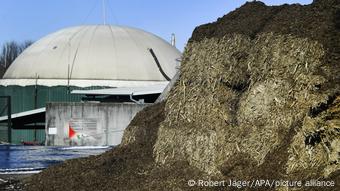
Immediately, as soon as you arrive from Germany to the territory of Denmark, biogas plants appear one after another on the way. It is not difficult to recognize them for their tall reactor towers, in which bacteria produce biogas from agricultural waste. It is easy to find them by smell, which Danes tolerate. The country’s government has relied on a consistent increase in biogas production to reduce dependence on natural gas.
One of the largest of these facilities operates in the community of Korskro, 15 kilometers from the North Sea port city of Esbjerg. Eight reactors with a volume of 9,000 cubic meters produce biogas from half-live manure and waste received from farms in the district, says Mette Hansen, an employee at the Danish company Nature Energy.
In Denmark, natural gas will be replaced by biomethane
The Korskro facility is one of 50 biomethane producers in Denmark. In 2021, biogas covered a quarter of the country’s blue fuel needs and, according to the authorities’ plans, by 2034 it should be 100 percent of consumption. Thus, the replacement of natural gas produced off the coast of the country is planned.
Biogas Station in Corskr
Denmark, unlike Germany, is not dependent on Russian gas supplies, but explores and exports blue fuel and aims to do so by 2035. However, there have recently been problems with its prey in the Tyra field on the Danish platform. Therefore, the transition to biogas proved to be timely and economically viable. “Whoever is now with such high prices cannot make money from their production, he himself is to blame”, says Mette Hansen.
In Germany, biogas is mainly used for electricity generation.
Biogas is 60% methane and 40% carbon dioxide. In Germany, this mixture is 95% used to produce electricity and heat. Only 250 of the 10,000 biogas installations in Germany produce biomethane, which is pumped into pipelines. According to the German Association of Biogas Producers (FV Biogás), it is responsible for 1% of the gas consumed in the country per year.
Reason: many facilities are located too far from pipelines or have very low power. “For them, the costs of connecting to the grid or retrofitting would be too high,” says Jörg Schäfer, spokesman for the association. However, in the case of approximately 2,000 installations, these costs would be offset. Shefer sees the problem in the fact that facility owners have no economic incentives. It is true that the German authorities have announced an annual bid for 600 megawatts of biomethane, but the problem cannot be solved by bidding alone, criticizes FV Biogas. According to him, the biogas auctions held in the past were not completely exhausted due to insufficient economic benefits.
Facility owners demand state guarantees, eg fixed income from the sale of biogas, in case prices are falling. “Otherwise, it will be difficult to find the necessary investments,” says Schaefer. One of the obstacles is regulatory restrictions in the building code. But there are no technical restrictions, and the rules governing access to the gas transport network even put biomethane manufacturers in a privileged position.
“Green” Prejudices About Biogas
There are political prejudices in relation to biogas. Thus, the Federal Association of Energy and Water Companies (BDEW) criticizes that thousands of biogas plants are threatened with closure due to the fact that the 20-year period of their economic support from the state under the renewable sources law of Energy is ending.

Agricultural waste is used to produce biogas
The Federal Ministry of Economy and Climate, which is headed by “Green” Robert Habeck, rejects the criticism. “Limited volumes of biomass make it impossible to increase biogas production and this is not appropriate,” the agency said in a statement. There are partisan ideological reasons behind this. A significant part of “green” refers to bioenergy with bias. They fear competition between biogas facilities and food manufacturers. This also applies to agricultural vehicles, since, from a “green” point of view, the active use of liquid manure and garbage would legitimize industrial livestock farming.
Unlike the German authorities, industry associations see great untapped potential in biogas. Thus, according to FV Biogás, in Germany, only half of the population’s organic waste from agriculture, industry and household waste is currently used for the production of biogas. And according to the study by the Technical University of Hamburg, only a quarter of the organic waste of the population’s life is used to produce biogas. If Germany uses the entire production of biomethane biomethane, it will be able to cover about 10% of the annual need for natural gas, the BDEW calculated.
Source: DW
James Springer is a renowned author and opinion writer, known for his bold and thought-provoking articles on a wide range of topics. He currently works as a writer at 247 news reel, where he uses his unique voice and sharp wit to offer fresh perspectives on current events. His articles are widely read and shared and has earned him a reputation as a talented and insightful writer.